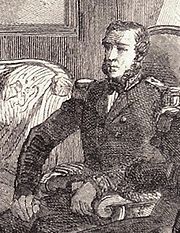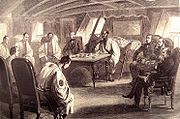
Edward St. John Neale
Encyclopedia



Great Britain
Great Britain or Britain is an island situated to the northwest of Continental Europe. It is the ninth largest island in the world, and the largest European island, as well as the largest of the British Isles...
in Japan
Japan
Japan is an island nation in East Asia. Located in the Pacific Ocean, it lies to the east of the Sea of Japan, China, North Korea, South Korea and Russia, stretching from the Sea of Okhotsk in the north to the East China Sea and Taiwan in the south...
in 1862-1863. Neale, who had been stationed in Beijing
Beijing
Beijing , also known as Peking , is the capital of the People's Republic of China and one of the most populous cities in the world, with a population of 19,612,368 as of 2010. The city is the country's political, cultural, and educational center, and home to the headquarters for most of China's...
from 1860 as Secretary of the Legation following the settlement of the Second Opium War
Second Opium War
The Second Opium War, the Second Anglo-Chinese War, the Second China War, the Arrow War, or the Anglo-French expedition to China, was a war pitting the British Empire and the Second French Empire against the Qing Dynasty of China, lasting from 1856 to 1860...
, was transferred to Japan in March 1862, when Rutherford Alcock
Rutherford Alcock
Sir Rutherford Alcock KCB was the first British diplomatic representative to live in Japan.-Early life:Alcock was the son of the physician, Dr. Thomas Alcock, who practised at Ealing, near London. As he grew up, Alcock followed his father into the medical profession...
went home on leave. Alcock returned to Japan in 1864 (to be replaced by Sir Harry Parkes as British Minister in Japan in 1865).
Actions in Japan
In March 1863, the Emperor of Japan issued an Order to expel barbariansOrder to expel barbarians
The was an edict issued by the Japanese Emperor Kōmei in 1863 against the Westernization of Japan following the opening of the country by Commodore Perry in 1854.-The order:...
, which led Neale to issue an ultimatum to the Japanese government, which was on the brink of starting a war with foreign powers in order to return to the isolation policy
Sakoku
was the foreign relations policy of Japan under which no foreigner could enter nor could any Japanese leave the country on penalty of death. The policy was enacted by the Tokugawa shogunate under Tokugawa Iemitsu through a number of edicts and policies from 1633–39 and remained in effect until...
. Neale was extremely vocal when the Bakufu, under pressure from the Emperor, was finally forced to issue a declaration promulgating the end of relations with foreigners. The order was forwarded to foreign legations by Ogasawara Zusho no Kami on June 24, 1863. Lieutenant-Colonel Neale, responded on very strong terms, equating the move with a declaration of war:
A few days later, on July 2, 1863, Colonel Neale led the negotiations for the reparations following the 1862 Namamugi incident
Namamugi Incident
The was a samurai assault on foreign nationals in Japan on September 14, 1862, which resulted in the August 1863 bombardment of Kagoshima, during the Late Tokugawa shogunate...
, in which foreigners were killed by a party from Satsuma, The failure of Satsuma to apologize and pay for reparations led to the Bombardment of Kagoshima
Bombardment of Kagoshima
The Bombardment of Kagoshima, also known as the , took place on 15–17 August 1863 during the Late Tokugawa shogunate. The British Royal Navy was fired on from the coastal batteries near town of Kagoshima and in retaliation bombarded the town...
by the Royal Navy
Royal Navy
The Royal Navy is the naval warfare service branch of the British Armed Forces. Founded in the 16th century, it is the oldest service branch and is known as the Senior Service...
in August 1863, in which Neale participated onboard the flagship Euralyus
HMS Euryalus (1853)
HMS Euryalus was a fourth-rate wooden-hulled screw frigate of the Royal Navy, with a 400HP steam engine that could make over 12 knots. She was launched at Chatham in 1853, was 212 feet long, displaced 3125 tons and had a complement of 515...
.
Modern appraisal
Neale recently received a rather mixed review in the 2004 book by Cortazzi on the relations between Japan and Great Britain:External links
- Sir Hugh Cortazzi (2003) "The British Bombardment of Kagoshima in 1863" The Asiatic Society of Japan http://www.asjapan.org/Lectures/2003/Lecture/lecture-2003-05.htm

